

6 Design Principles Of Connected Learning. The Learning And Design Principles Of Connected Learning by Terry Heick In 2015, no one should be hurting for compelling ed content.
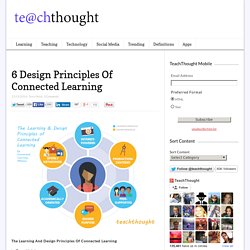
Sites like edutopia, The Tempered Radical, Langwitches, Justin Tarte, Cool Cat Teacher, Grant Wiggins’ blog, and dozens of others offer outstanding reading on a daily basis to help you improve the things that happen in your classroom. (And this list is frustratingly incomplete–they’re just the sites on my radar that I’ve been reading since I entered education.) A bit more “fringe” are sites like TeachThought, Jackie Gerstein’s UserGeneratedEducation, the Connected Learning Alliance and DMLCentral.net, MindShift, and so many more–“fringe” due to their thinking that seems as interested in understanding what’s possible in a modern learning environment as they are what is. You could even call this kind of content less immediately practical when you’re just Googling for a lesson idea for tomorrow, but there’s room for everyone in a digital and infinite world. 1. Collaborative learning. Kallidus at Learning Technologies 2015 With the buzz of Learning Technologies 2015 still with us back at the Kallidus offices, here’s our round-up of this year’s show… With more than 7,000 visitors, 150 free seminars, 250 exhibitors and two exhibition halls packed with the latest in learning technology and HR solutions, it’s easy to see why Learning Technologies is the now the fastest growing and most popular L&D conference in Europe.

The show took place 28-29 January at London Olympia, and the Kallidus experts were on hand to offer top tips and best practice advice to delegates and discuss the latest trends and technologies over a cup of organic coffee at our stand. Peer Learning Handbook. 20 Collaborative Learning Tips And Strategies For Teachers. 20 Collaborative Learning Tips And Strategies For Teachers by Miriam Clifford This post has been updated from a 2011 post.
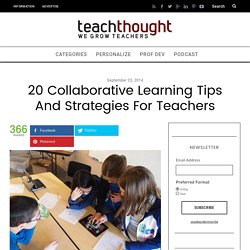
There is an age old adage that says “two heads are better than one”. Consider collaboration in recent history: Watson and Crick or Page and Brin (Founders of Google). But did you know it was a collaborative Computer Club about basic programming at a middle school that brought together two minds that would change the future of computing? Yes, those two were of course Bill Gates and Paul Allen, the founders of Microsoft.
Online Education Technology for Teachers and Students. 21C Learning Innovation. Powerful Learning: Studies Show Deep Understanding Derives from Collaborative Methods. Today's students will enter a job market that values skills and abilities far different from the traditional workplace talents that so ably served their parents and grandparents.
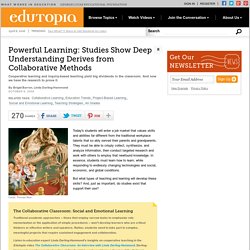
Collaborative Learning Environments Benefit Trainers Too. eLearning makes it possible to create collaborative learning environments.
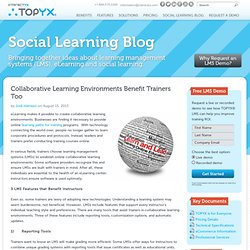
Businesses are finding it necessary to provide online learning paths for training programs. With technology connecting the world over, people no longer gather to learn corporate procedures and protocols. Instead, leaders and trainers prefer conducting training courses online. In various fields, trainers choose learning management systems (LMSs) to establish online collaborative learning environments.
Some software providers recognize this and ensure LMSs are built with trainers in mind. 3 LMS Features that Benefit Instructors Even so, some trainers are leery of adopting new technologies. 1) Reporting Tools. Teaching In The Cloud: How Google Docs Are Revolutionizing The Classroom. Google’s online word processor has transformed the way teachers support students through the writing process.

(alamosbasement/flickr) Any experienced English teacher knows the drill: on the dreaded due date, students bring printed copies of their essays to class, where we collect them, take them home, jot inscrutable comments in the margins, bring them back to class, return them, and then watch students promptly toss them in the recycling bin on the way out of the room. The whole cycle borders on farce. Students pretend to spend many hours writing their papers, teachers pretend to spend many hours grading them, and we all pretend like repeating this process over and over again leads to something we in education like to call “student growth.” But teachers can finally put an end to this exercise in futility, thanks to an unlikely hero sometimes condemned for its unrelenting pursuit of profit at the expense of the public good…Google. Related: Resources and Downloads for Collaborative Learning. Educators from The College Preparatory School in Oakland, California, have provided these resources and tools for collaborative learning.
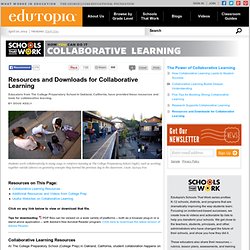
Students work collaboratively in many ways to reinforce learning at The College Preparatory School (right), such as working together outside (above) on geometry concepts they learned the previous day in the classroom. Credit: Zachary Fink Tips for downloading: PDF files can be viewed on a wide variety of platforms -- both as a browser plug-in or a stand-alone application -- with Adobe's free Acrobat Reader program. Click here to download the latest version of Adobe Reader. The virtual community. The A to Z of Social Media for Academia. The Learning Cycle of A 21st Century Student. 20 Tips for Creating a Professional Learning Network. “20 Tips for Creating a Professional Learning Network” by Miriam Clifford first appeared on the InfomED blog.
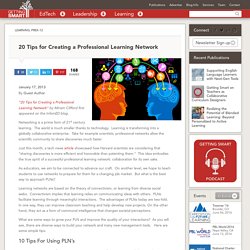
Networking is a prime form of 21st century learning. The world is much smaller thanks to technology. Learning is transforming into a globally collaborative enterprise. Take for example scientists; professional networks allow the scientific community to share discoveries much faster. Just this month, a tech news article showcased how Harvard scientists are considering that “sharing discoveries is more efficient and honorable than patenting them.” As educators, we aim to be connected to advance our craft. Learning networks are based on the theory of connectivism, or learning from diverse social webs. What are some ways to grow your PLN and improve the quality of your interactions? 10 Tips For Using PLN’s Keep the spirit of collaboration as your driving force. 10 Tools & Strategies for Establishing a Productive PLN Use Diigo, Evernote, Pocket, or Delicious to bookmark links. Let's Stop Confusing Cooperation and Teamwork with Collaboration.
Often the words collaboration, coordination, and cooperation are used to describe effective teamwork.

But they are not the same, and when we use these words interchangeably, we dilute their meaning and diminish the potential for creating powerful, collaborative workplaces. Collaboration has been a big word in the news lately, most recently due to Marissa Mayer’s explanation of her decision to bring Yahoo employees back to the office: “To become the absolute best place to work, communication and collaboration will be important, so we need to be working side-by-side.”